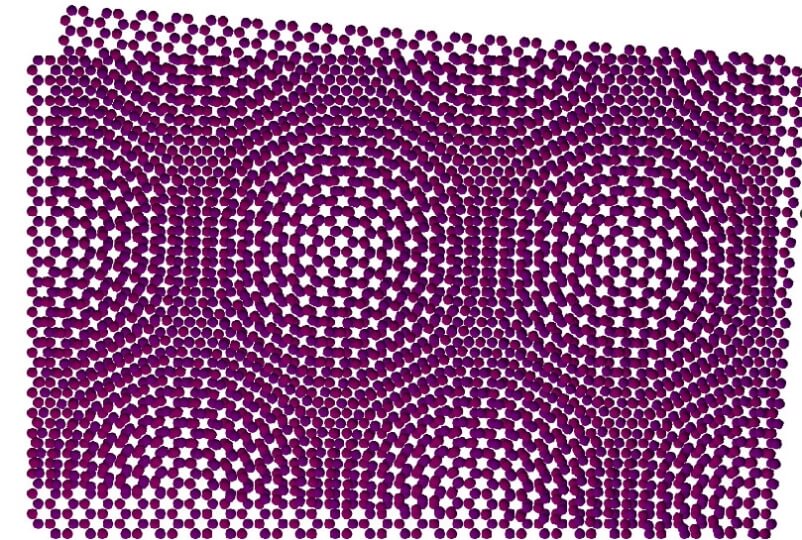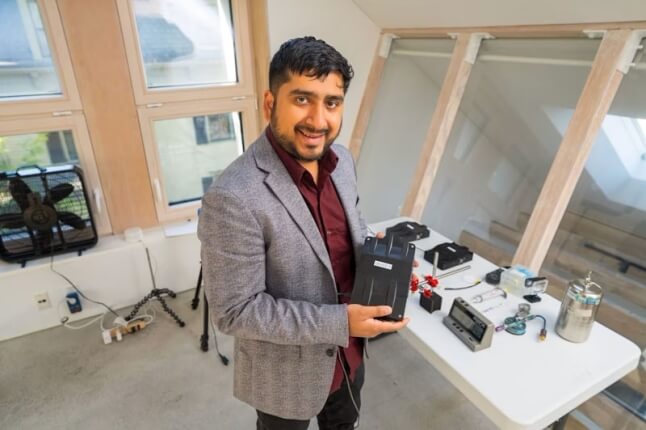News
Atomic scale moiré pattern created by overlapping two skewed sheets of graphene. (Image courtesy of Wikicommons)
The twist has been taking the field of condensed matter physics by storm. No, not the 1960s dance craze made famous by Chubby Checker— the stunning discovery that two sheets of graphene, a flat honeycomb-shaped lattice of carbon, could be stacked and twisted at so-called magic angles to exhibit vastly different properties, including superconducting behavior.
Since 2018, when the first experimental verification was published, researchers around the world have been exploring this rapidly expanding subfield of condensed matter physics and materials science. But when there are millions of different ways to stack and twist layers of two-dimensional materials such as graphene, how do you know which way will yield interesting properties?
That’s where two recent research articles from the Harvard John A. Paulson School of Engineering and Applied Sciences (SEAS) and the Department of Physics come in. First author of the publications Georgios Tritsaris, a research scholar at SEAS, with the research group of Efthimios Kaxiras, the John Hasbrouck Van Vleck Professor of Pure and Applied Physics in the Department of Physics and Director of the Institute for Applied Computational Science in SEAS, designed a computational system to screen twisted multi-layer graphene stacks for twist angles associated with potentially interesting electronic properties.
The approach can identify nanostructures with tailored properties that could help accelerate the development and commercialization of quantum and other technologies.
The research articles were published in 2D Materials and the Journal of Chemical Information and Modeling and were co-authored by Stephen Carr, Ziyan Zhu, Yiqi Xie, Steven Torrisi, Marios Mattheakis, Daniel Larson, and Alexander Rush from Harvard, and Jing Tang from Nanjing University.
The research builds on the team’s expertise in materials modeling and machine learning, and its previous work in this emerging field, named twistronics. The term twistronics was first introduced by the Kaxiras Research Group in earlier theoretical studies of layered graphene. It refers to the ability to tune the electrical properties of two-dimensional materials through a rotation between successive layers.
“Besides increasing our theoretical knowledge of arbitrarily layered graphene, an important goal was to minimize the need for time-consuming, trial-and-error experimentation since achieving a magic-angle configuration in the lab remains a painstaking endeavor,” said Tritsaris. “We wanted to develop an automated system that an experimentalist, engineer, or perhaps an algorithm, could use to quickly answer the question, is this layered configuration likely to be interesting or not.”
We wanted to develop an automated system that an experimentalist, engineer, or perhaps an algorithm, could use to quickly answer the question, is this layered configuration likely to be interesting or not.
To do that, the team leveraged existing knowledge about these materials. The material’s electrical properties are determined by how the energy of electrons throughout the layers varies as a function of their momentum. One indicator as to whether or not a twisted configuration will exhibit interesting electronic phenomena is whether the energy of a single electron in the presence of other electrons can be constrained to a narrow window, giving rise to nearly flat bands in the plots of electronic energy levels.
In order to look for these flat bands for a given configuration, the researchers used a supercomputer to perform accurate calculations of the allowed energy levels of electrons, combined with a computer vision algorithm commonly used in autonomous vehicles to spot flat objects such as lane dividers. The research team used the approach to quickly sort through stacks of graphene up to ten layers.
“By automating data collection and analysis and using machine learning to create informative visualizations of the entire database, we were able to search for magic-angle multi-layer graphene stacks in a resource-effective fashion,” said Tritsaris. “Our streamlined approach is also applicable to two-dimensional layered materials beyond graphene.”
Data-centric approaches for the discovery and optimization of materials are already being used in a range of fields, including in pharmaceuticals to identify new drug targets and in consumer electronics to find new organic light-emitting diodes (OLEDs) for TV screens.
“It is not always straightforward how to best leverage data mining and machine learning for materials research, as researchers are often dealing with sparse and high-dimensional data, and solutions tend to be domain-specific. We wanted to share our findings to increase confidence in combining physics-based and data-driven models, in a way which is going to be interesting and useful to scientists and technologists in the field of two-dimensional materials," said Tritsaris.
The research was supported in part by the Department of Energy (DOE) Office of Science (Basic Energy Science) under Award No. DE-SC0019300 and by the National Science Foundation Science and Technology Center for Integrated Quantum Materials under Grant No. DMR1231319. Calculations were performed on the Extreme Science and Engineering Discovery Environment (XSEDE), which is supported by National Science Foundation (NSF) grant number ACI-1548562.
Topics: Applied Physics, Quantum Engineering
Cutting-edge science delivered direct to your inbox.
Join the Harvard SEAS mailing list.
Scientist Profiles
Efthimios Kaxiras
John Hasbrouck Van Vleck Professor of Pure and Applied Physics
Press Contact
Leah Burrows | 617-496-1351 | lburrows@seas.harvard.edu




